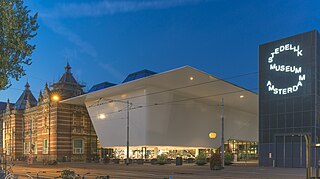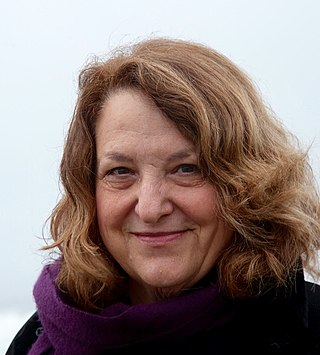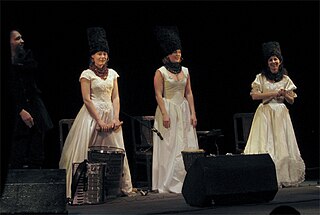The One Minutes is a global platform for one-minute videos. The One Minutes Foundation produces and distributes One Minutes, providing a platform for people to create and connect through short, accessible video art. [1]
The One Minutes is a global platform for one-minute videos. The One Minutes Foundation produces and distributes One Minutes, providing a platform for people to create and connect through short, accessible video art. [1]
The One Minutes was initiated in 1998 by Katja van Stiphout and Michal Buttink, two students of the Sandberg Institute, Masters of Art and Design. The institute’s director Jos Houweling was asked to fill in an hour of airtime on local television, SALTO, once a month from midnight to 1 a.m. and offered this to two of his students. They invited fellow students and friends to fill the timeslot with one-minute films. A new format was born. Within the inexorable limitation of 60 seconds, the endless possibilities of video were revealed. The hour at midnight grew into a worldwide platform, where television channels, arts organisations and film festivals adopted segments of One Minutes, showcasing one-minutes at film festivals, art organisations and cultural institutes. [2]
In 1999, The One Minutes Foundation was founded, under direction of Jos Houweling and supported by Sandberg Institute. Since then, The One Minutes Awards have been held annually to acknowledge the best One Minutes of the year. [3] The One Minutes held their first workshop in China in 2000 at Xiamen University. Ever since, The One Minutes has been a bridge of cultural exchange between international and Chinese artists, filmmakers and students. In 2008, Chinese artists took part in the Venice Biennale as part of The One Minutes. Since 2009, East China Normal University and Shanghai Dragon TV have been organising the yearly The One Minutes International Competition, which is broadcast by Dragon TV, Shanghai Media Group’s satellite broadcaster. One Minutes were also shown at EXPO Shanghai in 2010. Since 2011, The One Minutes has been a returning section in the annual Shanghai International TV Festival. [4]
In 2014, under the direction of Julia van Mourik, The One Minutes started a new curated programme: The One Minutes Series focusing on the perception and understanding of the moving image. In the new programme, The One Minutes focuses on the possibilities within a one-minute video and the boundaries of video art. [5]
Since 2017, The One Minutes is an independent non profit.
The One Minutes provides a place for artists and filmmakers within the intersection of art and film. Within the one minute video format, a maker can experiment and express themselves through moving image. [6]
In 2012, The One Minutes Collection and the Netherlands Institute for Sound and Vision in collaboration with BMW Group Netherlands, started to digitalize the collection. The goal was to the collection available for future generations.
Since 2020, The One Minutes Collection is published on the search portal for the general public (GPP), the search portal for media professionals (MPP), the Education Platform (OMP) and the Clariah Mediasuite, a portal for researchers at the Netherlands Institute for Sound and Vision. Licensing and reuse are handled by The One Minutes. Publication requests for television are processed by The Netherlands Institute for Sound and Vision. The collection includes over 17.000 one-minute videos from around 120 countries and has grown to include a diverse selection of video art. [7]
Workshops are organised by The One Minutes in collaboration with the Sandberg Institute and other art education programmes. The One Minutes also organizes workshops for asylum seekers and youngsters under The One Minutes Jr. In such workshops, artists collaborate with students, amateurs and children. [8]
Workshops for The One Minutes included 'Mind-body-problem', a collaboration with Maastricht Institute of Arts in the summer of 2021. 'Mind-body-problem' is curated by Sander Breure and Witte van Hulzen to depict the relation between the soul and the body.
Workshops for The One Minutes Jr. take place over the course of five days, where video artists teach basic camera and directing skills as well as creative thinking and story-telling. Each participant develops their own One Minute which is screened at the end of the workshop.
The One Minutes releases a new series of one-minute films every two months. These series explore current times through moving images. Guest curators are invited to conceive and curate a series. They send out an open call for submissions and also utilize The One Minutes Collection to compile the series.
The One Minutes Series were exhibited amongst others at Art Museum of Nanjing University of the Arts (CN), De Pont Museum of Contemporary Art (NL), Power Station of Art (CN), National Gallery of Iceland (IS) and Whitney Museum of American Art (USA) and screened at amongst others Durban International Film Festival, International Documentary Film Festival Amsterdam, International Short Film Festival Oberhausen, and Reykjavík International Film Festival.
'Imagine The Earth Is Your Lover' (2020) is curated by Annie Sprinkle and Beth Stephens. The series documents the ecosex movement through one minutes by 23 artists and filmmakers. The series transforms 'Earth as Mother' to 'Earth as Lover' and showcases a mutual, sustainable relationship between filmmakers and the Earth.
'Imagine The Earth Is Your Lover' premiered in September 2020 at Reykjavík International Film Festival. The series premiered online in October 2020 at Het Nieuwe Instituut. [6] Other screenings involve Performance Space New York and the Franconia Sculpture Park. [9]
'Ways of Something' (2014) is a series curated by Lorna Mills consisting of four episodes. Episode one and two were produced by The One Minutes, episode three and four were produced by Lorna Mills. The series is a contemporary remake of the BBC documentary 'Ways of Seeing', made in 1972 by John Berger.
Within the videos, a combination of formal, figural and kitsch practices are featured. 'Ways of Something' shows diverse interpretations of Berger's manner of looking at art after the introduction of the internet and digital media. The episodes together contain One Minutes from 113 network-based artists. These artists are working in 3D rendering, film remix, gifs, websites and webcam performances to explore art making after the introduction of the internet.
The episodes were debuted at TRANSFER Gallery in New York in September 2014. 'Ways of Something' was on view and subsequently included in the collection of Whitney Museum of American Art in 2016. [10]
'The One Minutes Jr. Ukraine' was produced in 2022, at the request of International Short Film Festival Oberhausen. A compilation of 46 One Minutes produced in Ukraine with The One Minutes Jr. was made, which premiered at the festival. The series premiered online at Het Nieuwe Instituut and toured filmfestivals throughout 2022. [11]
In 2002, The One Minutes Jr. was initiated by The One Minutes Foundation, European Cultural Foundation and UNICEF, to support social change, organising workshops for youngsters all over the world. In 2015 alone, they travelled to Albania, Azerbaijan, Cambodia, Kyrgyzstan, Myanmar, The Philippines, South Sudan and Ukraine.The One Minutes Jr. is a project of The One Minutes established with the European Cultural Foundation in 2002. The One Minutes Jr. collaborates with youth from ages 12 and up, from all over the world through video workshops. Since 2002, nearly 4.000 youngsters have participated from over 100 countries. [12]
The One Minutes Jr. videos are promoted amongst broadcasters and films are screened at exhibition venues, film festivals, art fairs, cinemas, galleries, art websites and museums. Distributors include the BBC, EYE Film Institute, W139, NRK and NOS Jeugdjournaal.
Each year, The One Minutes Jr. Award is presented. Fifteen nominees from around the world are invited to the Netherlands to attend the award ceremony, where three winners are awarded a Tommy award. [12]
In 2016 and 2017, The One Minutes Jr. travelled to Ukraine to give workshops in Avdiivka, Bakhmut, Dobropillia, Kharkiv, Liman, Mariupol, Melitopol, Sievierodonetsk, Sloviansk and Volnovakha. The workshops explored the influence of war on daily life in Ukraine, as well as the fears and dreams of Ukrainian youth. In 2022, with the Russian invasion of Ukraine the relevance of the series was prominent. A compilation of 46 One Minutes titled 'The One Minutes Jr. Ukraine' was published in a series. [12]
In 2023, The One Minutes Jr. worked with Rohingya refugees in refugee camps in Cox's Bazar, Bangladesh.

For EAST EAST Tokyo, 2023, The One Minutes projected videos on eight screens on Shibuya Crossing. [13] The series 'The BOLOHO Series' curated by the BOLOHO Collective and 'REST HARD: an act of doing nothing in a safe company' curated by Party Office were shown. [9]
In 2019 at the Stedelijk Museum Amsterdam, the sixth edition of Video Club was presented by The One Minutes in collaboration with guest-curator Harm van den Dorpel. Here, the series 'Artificial Scarcity' was presented alongside a selection of video art from the collection of the Stedelijk Museum. [14]
‘How To’, conceived by Hars Aarsman in 2014, is a compilation of short films that deal with convenient tips. The one-minutes featured teach the viewer something: from tying shoe laces with one hand to separating egg yolk and white. One Minutes from 'How To' were shown at Museum De Pont between May and August 2014. [15]
From June 11 to July 13, 2014, Power Station of Art exhibited The One Minutes on Tour - Shanghai / 一 分钟影像世纪巡回展(上海首展). The exhibition focused on the perception of the moving image and celebrated The One Minutes’ 15-year anniversary. The exhibition featured eleven screens showing over 300 one-minute videos. The exhibition was accompanied by a printed catalog.

The Stedelijk Museum Amsterdam, colloquially known as the Stedelijk, is a museum for modern art, contemporary art, and design located in Amsterdam, Netherlands.

The Tribeca Festival is an annual film festival organized by Tribeca Productions. It takes place each spring in New York City, showcasing a diverse selection of film, episodic, talks, music, games, art, and immersive programming. The festival was founded by Robert De Niro, Jane Rosenthal, and Craig Hatkoff in 2002 to spur the economic and cultural revitalization of Lower Manhattan following the September 11, 2001, attacks on the World Trade Center. Until 2020, the festival was known as the Tribeca Film Festival.

René Balcer is a Canadian-American television writer, director, producer, and showrunner, as well as a photographer and documentary film-maker.

Lynn Hershman Leeson is an American multimedia artist and filmmaker. Her work with technology and in media-based practices is credited with helping to legitimize digital art forms. Her interests include feminism, race, surveillance, and artificial intelligence and identity theft through algorithms and data tracking.
Ali Hossaini is an American artist, philosopher, theatrical producer, television producer, and businessperson. In 2010, The New York Times described him as a "biochemist turned philosopher turned television producer turned visual poet". In 2017 Hossaini published the Manual of Digital Museum Planning and subsequently became co-director of National Gallery X, a King's College London partnership that explores the future of art and cultural institutions. Prior to National Gallery X Hossaini worked with King's College to develop Connected Culture, an action research programme that tested cultural applications for 5G supported by Ericsson. As a working artist and producer, Hossaini's genre-spanning career includes installations, performances and hundreds of media projects. Since 2018 Hossaini has worked with security think tank Royal United Services Institute and, in a 2019 special edition of its journal, he assessed the threat from AI from the perspective of biology.

Sergei Sviatchenko is a Danish-Ukrainian architect, artist, photographer and curator. He is a representative of the Ukrainian New Wave, that arose in Ukraine up through the 1980s. Initiator and creative director of the Less Festival of Collage, Viborg and Just A Few Works. He has lived in Denmark since the 1990s. Sviatchenko graduated from the Kharkov National University of Construction and Architecture in 1975, and in 1986 he obtained a Ph.D. at the National Academy of Visual Arts and Architecture. Sviatchenko is the son of architect Evgenij Sviatchenko (1924–2004), who was a professor of architecture and a member of the National Ukrainian Academy of Fine Arts and Architecture, and engineer Ninel Sviatchenko (1926–2000). In 1975 Sergei Sviatchenko completed his architectural studies at the Kharkov National University of Construction and Architecture. Sergei Sviatchenko is especially oriented towards architecture's modern expressions, including Constructivism and the contemporary European Bauhaus movement. From his teacher, Professor Viktor Antonov, Sviatchenko was introduced to the film director Andrei Tarkovsky, and particularly his film Mirror from 1975 has left a thematic footprint in Sviatchenko's more recent collage art. After having worked as an architect for a number of architectural firms in Kharkov until 1983, Sviatchenko moved to Kyiv, where he graduated the master's program at the Kyiv National University of Construction and Architecture, having completed his Ph.D. dissertation "Means to Visual Information in Architecture".

Anton Vidokle is an artist and founder of e-flux. Born in 1965, Vidokle lives in New York and Berlin.

UCCA Center for Contemporary Art or UCCA is a leading Chinese independent institution of contemporary art. Founded in 2007 and located at the heart of the 798 Art District in Beijing, China, it welcomes more than one million visitors a year. Originally known as the Ullens Center for Contemporary Art, UCCA underwent a major restructuring in 2017 and now operates as the UCCA Group, comprising two distinct entities: UCCA Foundation, a registered non-profit that organizes exhibitions and research, stages public programs, and undertakes community outreach; and UCCA Enterprises, a family of art-driven retail and educational ventures. In 2018, UCCA opened an additional museum, UCCA Dune, in Beidaihe, a seaside resort town close to Beijing. In 2021, a third site in Shanghai was opened, UCCA Edge. The museum had 385,295 visitors in 2020, and ranked 55th in the List of most-visited art museums in the world.
Jennifer Vanderpool is an American artist living and working in Los Angeles. In her work "there is a chipper cynicism to the retro character of the figures, buildings, fashions, and patterns, so that there is certainly a sense of tradition, yet there is also a sense of transference and surrealism."

DakhaBrakha are a Ukrainian folk music quartet which combines the musical styles of several ethnic groups. They were a winner of the Sergey Kuryokhin Contemporary Art Award in 2009 and the Shevchenko National Prize in 2020.
Lorna Mills is a Canadian net.art and new media artist who is known for her digital animations, videos, and GIFs. Mills has done work in other mediums such as installations. Her work explores how "the notion of public decency is anachronistic" Her use of GIFs are gathered through the dark net which includes 4chan, pornfails, and Russian domains. She currently lives and works in Toronto, Canada.
Melanie Bonajo (they/them) is a queer, non-binary, Dutch artist, filmmaker, feminist, sexological bodyworker, somatic sex coach and educator, cuddle workshop facilitator and animal rights activist. Through their videos, performances, photographs and installations, Bonajo examines current conundrums of co-existence in a crippling capitalistic systems, and address themes of eroding intimacy and isolation in an increasingly sterile, technological world.
Việt Lê is a Vietnamese-born American artist, writer, and curator. Lê is an associate professor at the California College of the Arts.
Jennifer Chan is a Canadian media artist, curator, and programmer based in Toronto, Ontario. She is known for work that addresses how gender and race manifest in the fields of digital and online art, using amateur aesthetics inspired by pop culture, YouTube mashups, and millennial experience.
Faith Holland is a new media artist based in New York City. Her work engages with deconstructing female sexualization in the digital space and incorporates sculpture, video, and photography.

John Sanborn is a key member of the second wave of American video artists that includes Bill Viola, Gary Hill, Dara Birnbaum and Tony Oursler. Sanborn's body of work spans the early days of experimental video art in the 1970s through the heyday of MTV music/videos and interactive art to digital media art of today.
Bêka & Lemoine are artists, filmmakers and researchers working at the crossroads of visual arts, non-fiction cinema and architecture. Working together since 2005 they have been experimenting with new narrative and cinematic forms to explore how people experience, perceive, and relate to space from an emotional, social, and cultural standpoint. The duo has been described by the Barbican Center as one of the most important architectural artists working today. In 2016, MoMA, Museum of Modern Art in New York, acquired their entire body of work—16 films at the time—which now forms part of its permanent collection. The acquisition of an artist's complete body of work by the Museum of Modern Art (MoMA) is an exceptionally rare honor for a living artist.
Lorna Boschman (1955) is a Canadian Queer media artist, film maker, curator, educator, editor, and camera operator working with themes such as sexual identity, body image, social justice, (dis)ability, cancer, abuse, health, and self-advocacy.
Ho Tzu Nyen is a Singaporean contemporary artist and filmmaker whose works involve film, video, performance, and immersive multimedia installations. His work brings together fact and myth to mobilise different understandings of Southeast Asia's history, politics, and religion, often premised upon a complex set of references from art history, to theatre, cinema, and philosophy. Ho has shown internationally at major exhibitions such as the Aichi Triennale, Japan (2019), the Sharjah Biennial 14, United Arab Emirates (2019), and the Gwangju Biennale, South Korea (2018). In 2011, Ho represented Singapore at the 54th Venice Biennale at the Singapore Pavilion, presenting the work The Cloud of Unknowing.

Ukrainian animation, which began in the late 1920s, is part of Ukrainian cinematography and has involved a variety of techniques, including frame-by-frame filming, time lapse, and computer animation.